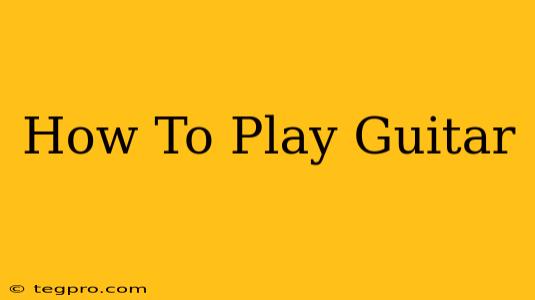So, you want to learn how to play the guitar? That's fantastic! The guitar is a rewarding instrument, offering a lifetime of musical enjoyment. This guide will walk you through the essential steps to get you started on your musical journey.
Getting Started: Essential Gear
Before you strum your first chord, you'll need a few things:
- A Guitar: Start with an acoustic guitar. They're generally more affordable and don't require amplification. Consider a smaller-bodied guitar if you have smaller hands. Don't break the bank on your first guitar; a decent beginner model will suffice.
- A Tuner: Essential for keeping your guitar in tune. You can find clip-on tuners, apps for your smartphone, or even online tuners. Accurate tuning is crucial for a good sound.
- A Pick (Plectrum): Experiment with different thicknesses to find what feels comfortable. A medium-gauge pick is a good starting point.
- A Guitar Strap (Optional but Recommended): A strap allows you to play comfortably while standing.
- A Guitar Case or Gig Bag: Protecting your investment is key.
Learning the Basics: Holding the Guitar and Forming Chords
Posture is Key
Sit or stand with good posture. Keep your back straight and your shoulders relaxed. This will make playing more comfortable and prevent strain.
Holding the Pick
Hold the pick between your thumb and index finger, allowing it to rest lightly against your middle finger. Experiment with different grips to find what feels most natural.
Your First Chords
Start with easy chords like G major, C major, and D major. There are plenty of resources online (YouTube tutorials are excellent!) showing you how to finger these chords correctly. Practice switching smoothly between them. Don't worry about perfection at first; focus on getting your fingers in the right positions.
Practicing Effectively: Consistency is Crucial
- Set Realistic Goals: Don't try to learn everything at once. Focus on mastering a few chords and simple strumming patterns before moving on to more complex techniques.
- Practice Regularly: Even short, consistent practice sessions are more effective than infrequent, long ones. Aim for at least 15-30 minutes of practice most days.
- Be Patient: Learning guitar takes time and dedication. Don't get discouraged if you don't sound perfect right away. Celebrate small victories and enjoy the process!
- Listen to Music: Immerse yourself in the music you love. Pay attention to guitar parts and try to identify chords and rhythms.
Expanding Your Skills: Beyond the Basics
Once you've mastered a few basic chords and strumming patterns, you can explore:
- More Complex Chords: Learn barre chords, minor chords, and seventh chords to expand your musical vocabulary.
- Strumming Patterns: Experiment with different strumming patterns to add rhythm and dynamics to your playing.
- Fingerpicking: Fingerpicking is a beautiful technique that allows you to play melodies and harmonies simultaneously.
- Guitar Tabs (Tablature): Tabs are a simplified way of reading guitar music. They're a great resource for learning new songs.
Finding Resources and Support
- Online Tutorials: YouTube is a treasure trove of guitar lessons for all levels.
- Guitar Teachers: A qualified teacher can provide personalized instruction and feedback.
- Guitar Apps: Numerous apps offer interactive lessons and exercises.
- Online Communities: Connect with other guitar players online for support and motivation.
Learning to play the guitar is a journey, not a race. Enjoy the process, be patient with yourself, and most importantly, have fun! With consistent practice and dedication, you'll be playing your favorite songs in no time.

